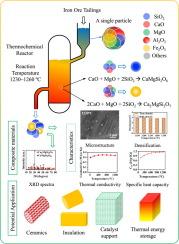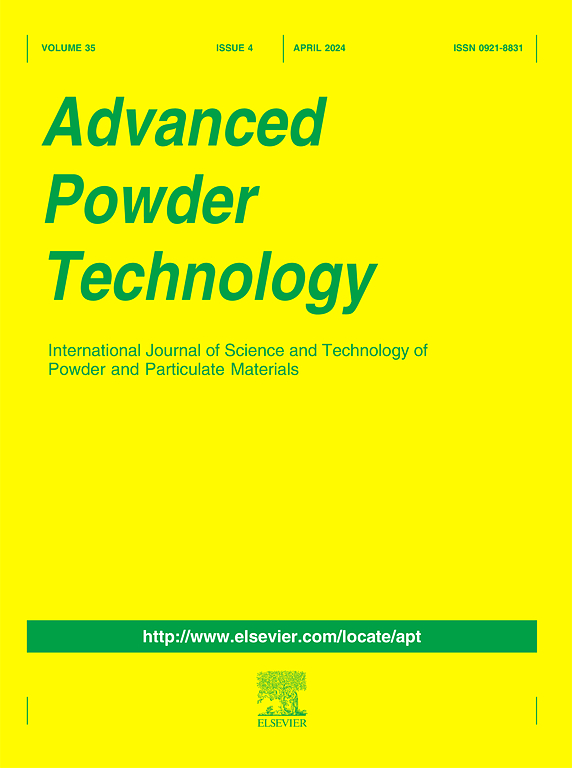High-temperature thermochemical conversion of iron ore tailings into diopside and akermanite-based composite materials
IF 4.2
2区 工程技术
Q2 ENGINEERING, CHEMICAL
引用次数: 0
Abstract
Iron ore tailings (IOTs), the residue materials generated during iron ore processing, pose environmental challenges due to their massive volume and potential impact on ecosystems. This study proposes a sustainable approach to manage and utilize this solid waste by converting it into value-added composite materials through high-temperature thermochemical reactions. Experiments are conducted in a tubular reactor at various reaction temperatures and times, and the resulting product samples are comprehensively characterized to elucidate their chemical compositional, physical, microstructural, thermal, and electrical properties. The results reveal that at optimal reaction temperatures (1230–1260 °C) and reaction times (20–120 min), the synthesized product is predominantly composed of diopside (CaMgSi2O6) and akermanite (Ca2MgSi2O7). Additionally, we demonstrate that the product can be diopside-rich or akermanite-rich when blending silica and MgO powders into the IOTs to control the starting material composition, opening a promising avenue for large-scale sustainable utilization of industrial solid waste.

将铁矿尾矿高温热化学转化为透辉石和赤铁矿基复合材料
铁矿石尾矿(IOTs)是铁矿石加工过程中产生的残留物,由于其数量巨大且对生态系统有潜在影响,因此给环境带来了挑战。本研究提出了一种可持续的方法来管理和利用这种固体废弃物,通过高温热化学反应将其转化为高附加值的复合材料。实验在管式反应器中以不同的反应温度和时间进行,并对所得产品样品进行全面表征,以阐明其化学成分、物理、微结构、热和电特性。结果表明,在最佳反应温度(1230-1260 °C)和反应时间(20-120 分钟)下,合成产物主要由透辉石(CaMgSi2O6)和赤铁矿(Ca2MgSi2O7)组成。此外,我们还证明了在 IOT 中掺入二氧化硅和氧化镁粉末以控制起始材料成分时,产物可以是富含透辉石的,也可以是富含赤铁矿的,这为大规模可持续利用工业固体废弃物开辟了一条前景广阔的途径。
本文章由计算机程序翻译,如有差异,请以英文原文为准。
求助全文
约1分钟内获得全文
求助全文
来源期刊

Advanced Powder Technology
工程技术-工程:化工
CiteScore
9.50
自引率
7.70%
发文量
424
审稿时长
55 days
期刊介绍:
The aim of Advanced Powder Technology is to meet the demand for an international journal that integrates all aspects of science and technology research on powder and particulate materials. The journal fulfills this purpose by publishing original research papers, rapid communications, reviews, and translated articles by prominent researchers worldwide.
The editorial work of Advanced Powder Technology, which was founded as the International Journal of the Society of Powder Technology, Japan, is now shared by distinguished board members, who operate in a unique framework designed to respond to the increasing global demand for articles on not only powder and particles, but also on various materials produced from them.
Advanced Powder Technology covers various areas, but a discussion of powder and particles is required in articles. Topics include: Production of powder and particulate materials in gases and liquids(nanoparticles, fine ceramics, pharmaceuticals, novel functional materials, etc.); Aerosol and colloidal processing; Powder and particle characterization; Dynamics and phenomena; Calculation and simulation (CFD, DEM, Monte Carlo method, population balance, etc.); Measurement and control of powder processes; Particle modification; Comminution; Powder handling and operations (storage, transport, granulation, separation, fluidization, etc.)
 求助内容:
求助内容: 应助结果提醒方式:
应助结果提醒方式:


